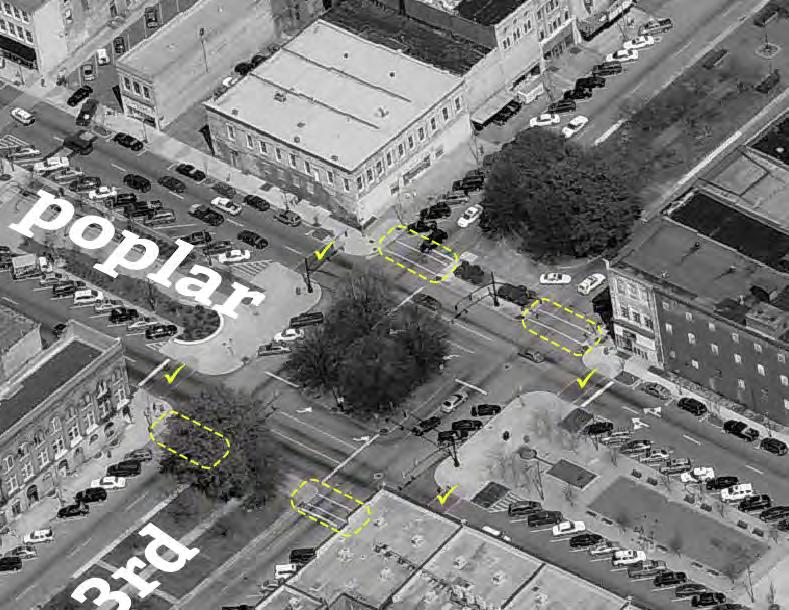
11 minute read
Action: Re-route trucks away from Downtown
4.2b) Prioritize pedestrian safety and connectivity at signalized intersections
Background: Pedestrian safety is a primary concern in the Macon community. According to Dangerous by Design 2014, a report by Smart Growth America, the Macon metropolitan area had the highest annual pedestrian death rate (3.44 per 100,000) during 2008-2012 of any other metropolitan area in Georgia. While the next highest rate was Brunswick, Georgia (3.39), most of the other metropolitan areas were below 2. The Atlanta metropolitan area, for example, experienced 1.59 pedestrian deaths out of 100,000.
Advertisement
Key ideas: Pedestrian countdown signals, leading pedestrian intervals, prohibit right turns on red, eliminate double signals, international crosswalks
Action: Pedestrian countdown signals Introduce pedestrian countdown signals, which provide information to pedestrians on how many seconds are remaining to cross the street. Existing traffic signals should be retrofitted with this infrastructure.
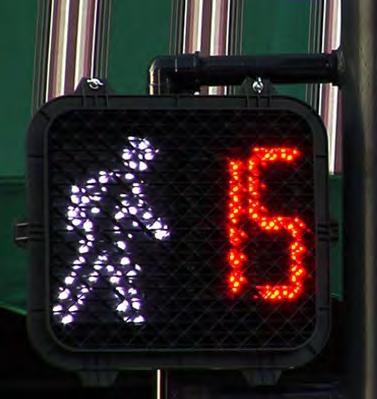
Leading pedestrian intervals Introduce leading pedestrian intervals (typically three to five seconds) to delay car movements and invite pedestrians to begin crossing first before vehicles get a green light. This treatment will have minimal impact on the operations of vehicles and come to the considerable benefit of pedestrians.
Prohibit right turns on red Prohibit right turns on red. Allowing vehicles to turn right when they have a red light was initially allowed to improve vehicle delay at intersections where additional capacity could not be built. However in areas where there are large volumes of pedestrians, allowing right turns on red is a serious pedestrian safety concern. Eliminate double signals At the major intersections with perpendicular medians (ex. Mulberry & 3rd or Poplar $ 3rd), eliminate the traffic duplicative traffic lights that allow drivers to stop in the center of intersections, leaving only the initial light on the first side of the intersection, and enhancing the sense of safety for pedestrians.
International crosswalks Upgrade all ‘marked’ crosswalks downtown to international crosswalks. These crosswalks have an appearance similar to piano keys and have been proven to provide the most awareness to drivers of crossing pedestrians.
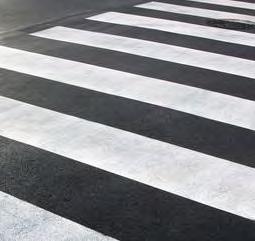
Macon-Bibb County and the UDA should identify high priority intersections to pilot leading pedestrian intervals and prohibit right turns on red, preferably on Cherry Street and Second Street. These pilots should evaluate the actual and perceived changes with respect to pedestrian comfort and vehicular delay. Pedestrian countdown signals should be installed with all new traffic signals and retrofitted at existing traffic signal locations where pedestrians have to cross more than two lanes of traffic. marked crosswalk brick crosswalk eliminate double signal
Detailed strategies for intersection improvements designed to support pedestrian activity are included in Strategy 1.4b (Gateways) and Strategy 2.3c (East Macon) and 2.3d (Pleasant Hill).
4.2c) Develop pedestrian encouragement and education programs
Background: Public messaging and programming reinforces improvements to pedestrian infrastructure through the support and encouragement of pedestrian safety and activity. Programming that focuses on specific goals and monitors progress, e.g. through the use of wearable devices like a pedometer, are more effective than those with abstract goals, e.g. those that simply encourage walking.
Key ideas: pedestrian safety brochure, Mayor’s Challenge, activity challenge, pedestrian & bicycle safety committee
Action: Create an encouragement program to undertake the following:
• Develop a pedestrian safety brochure and include it with county mailings on traffic violations
• Join the Mayors’ Challenge for Safer People, Safer Streets by having the Mayor leading a call to action on pedestrian safety
• Develop an activity challenge using pedometers or wearable devices that reward people for the number of steps they take
• Develop a pedestrian & bicycle safety committee that meets regularly on issues that affect downtown
The UDA should partner with Navicent to develop the pedestrian safety brochure and the activity challenge. Local businesses should be made aware of both efforts and encouraged to sponsor, either monetarily or with in-kind donations. The UDA should help establish the safety committee, which should be a volunteer run group.
HOW IT’S DONE ELSEWHERE
Mayors’ Challenge for Safer People, Safer Streets, nationwide www.dot.gov/mayors-challenge
This effort invites mayors and elected city officials to participate in a year-long challenge. City leaders engage a call to action, form a local action team, and take at least one of the Challenge activities, which include a complete streets approach, addressing barriers to safety and accessibility, and context-appropriate design, among others.
Walk! Tullahoma Pedometer Challenge, Tullahoma, TN www.tullahomatn.gov/get-fit/; www.tullahomatn.gov/walk-tullahoma-pedometer-challenge/
The Walk! Tullahoma Pedometer Challenge is sponsored by the Get Fit! Initiative in City of Tullahoma. Participants of all ages and abilities sign a “fitness pledge” committing to walking 7,500 steps daily (or roughly 3 miles), making healthy dietary decisions, and using good health to do good in their communities. They also receive a free digital pedometer and instructions on how to use it. The first year of the challenge was 2014 and lasted for roughly seven weeks from July to September. Each participant who met the goal of 7,500 steps a day was entered into a weekly drawing for a pair of running shoes. The 80 participants in the challenge logged a total of 13,500 miles.

Goal:
4.3 IMPROVE MULTI-MODAL TRANSPORTATION OPTIONS
4.3a) Improve bus/shuttle connections
Background: As the Urban Core continues to attract more residents, employees, and visitors, it is likely that there will be a greater demand for public transportation. Moreover, this increase in population will result in greater demand to connect downtown with large job centers, such as Warner Robins Air Force Base.
Buses and shuttles are the most effective way to move a large amount of people between two destinations if additional transportation infrastructure, such a light rail, is not already present. While Terminal Station offers bus service and provides connections to some regional locations, its location is disconnected from downtown. To improve ridership of public transportation, Terminal Station must first and foremost be seen as a transportation destination. As described in Strategy 1.2b, improvements to Cherry Street Plaza will also help bring potential passengers closer to transit options.
Key ideas: improvements to level of service, integration of Terminal Station, regional BRT transit service
Action: Improvements to level of service To seize on the opportunity a growing Urban Core presents to the public transportation system, its current level of service should improve with respect to comfort, reliability, and overall experience in buses and shuttles.
Integration of Terminal Station Better connections to Terminal Station will result from first improvements to pedestrian connections on MLK Drive and the creation of a regional transit system with Terminal Station as the hub. Consideration should be given to providing high quality and reliable bus service, such as regional bus rapid transit, to large job centers such as Warner Robins Air Force Base as demand warrants. Providing bus/shuttle service to the Atlanta Airport would also serve a need for many residents and students who instead must find transportation to the current shuttle pick-up location in North Macon.
Regional BRT service The UDA, Macon-Bibb County, and the Macon Transit Authority should all collaborate to identify potential opportunities for regional bus rapid transit service and work with private shuttle operators to initiate service between Terminal Station and Atlanta Airport.
4.3b) Improve bicycle infrastructure
Background: The opportunity exists for Macon to be one of the best cities in the South for biking for all ages and abilities. Currently, cyclists are able to use the Ocmulgee River Heritage Trail, and a bike path exists on the recently completed vision block on Second Street. The trail and bike lane create a safer atmosphere for people to ride their bike on the street, but additional investment is needed to spur ridership. This investment should focus on an expanded network of on-street bike trails and increased access to bicycles.
Key ideas: on-street bike lanes, bike share, group rides
Action: On-street bike lanes Connect downtown with the proposed Heritage Trail Loop to create a unique facility that is both safe and fun to travel on. Bike lanes should be installed on the rest of Second Street, Forsyth Street, and portions of MLK Drive and Fifth Street to provide initial connections. Ensure that this network also reaches into adjacent neighborhoods, with bike paths along Ogelthorpe Street, Walnut Street, and College Street, among others. Additional bike parking should be installed in the Urban Core to accompany the expanded bike network, particularly along Cherry Street.

Bike share
Bike share is a new form of transit that increases access to bicycles without requiring an actual purchase of a bicycle. It removes many of the challenges of biking in urban areas, such as parking and concerns about theft. Through a membership (which can be free or cost up to $65 depending on the vendor), users may pick up a bike from a bike share “station”, ride to their destination, and drop the bike at the nearest bike share station. The Urban Core could support a bike share network of 15 to 20 stations, and College Hill has begun investigating this opportunity with a feasibility study.
Group rides
The final piece to building a bicycling community is encouraging people to ride. Support the group rides organized by CHA, as the more opportunities for people to ride in groups and get new people on a bike, the larger the potential ridership base will grow.
Macon-Bibb should stripe bike lanes on 2nd Street (as part of the overall 2nd Street project), Forsyth Street, and MLK Drive into Fifth Street. UDA should partner with College Hill Alliance to complete a bike share feasibility study and develop an implementation plan. UDA should work with partnership organizations on potential additional group rides.
HOW IT’S DONE ELSEWHERE
Capital Bikeshare, Washington, DC www.dot.gov/mayors-challenge
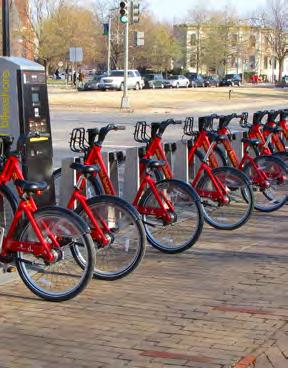
Capital Bikeshare was introduced in the capital in 2010 and has grown to include approximately 2,500 bikes, 300 stations, and 5,700 users. A 2013 survey found that 25% of those surveyed reduced their driving miles since joining the program. In addition, 40% of survey participants indicated that the bike share program opened them up to locations they would otherwise not have gone to due to difficulties associated with travel, including traffic congestion.
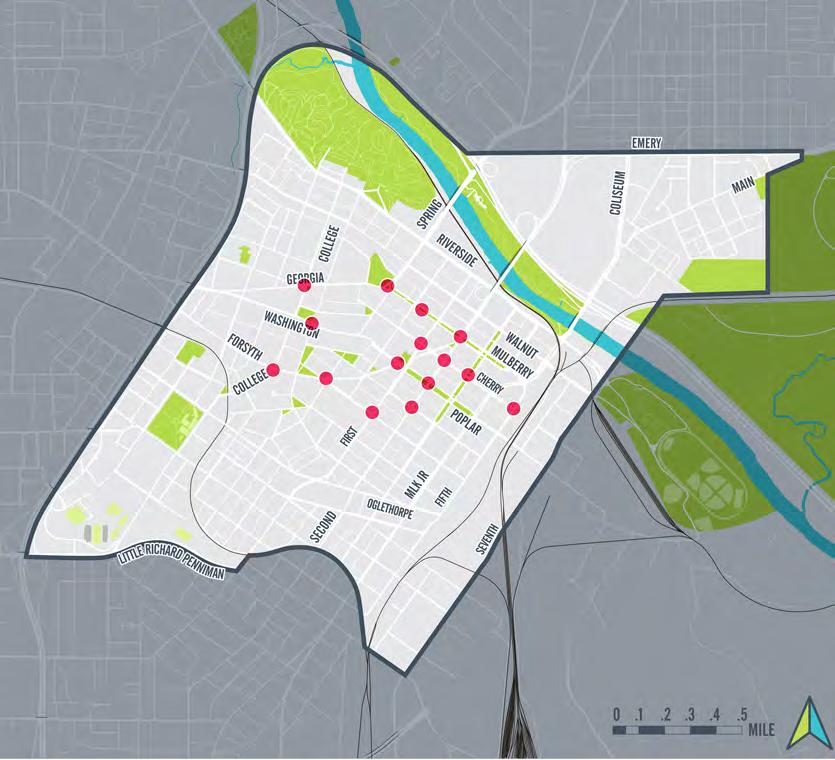
4.3c) Improve the pedestrian experience
Background: Downtown has the greatest opportunity to encourage more walking and activity along sidewalks. Just as Mercer Village invested in new infrastructure, sidewalks and streetscape to promote walkability and support local businesses, downtown requires the same consideration. Today, many of downtown’s sidewalks are deteriorated and the look and feel of the streets require a refresh with a design treatment that is consistent across downtown streets.
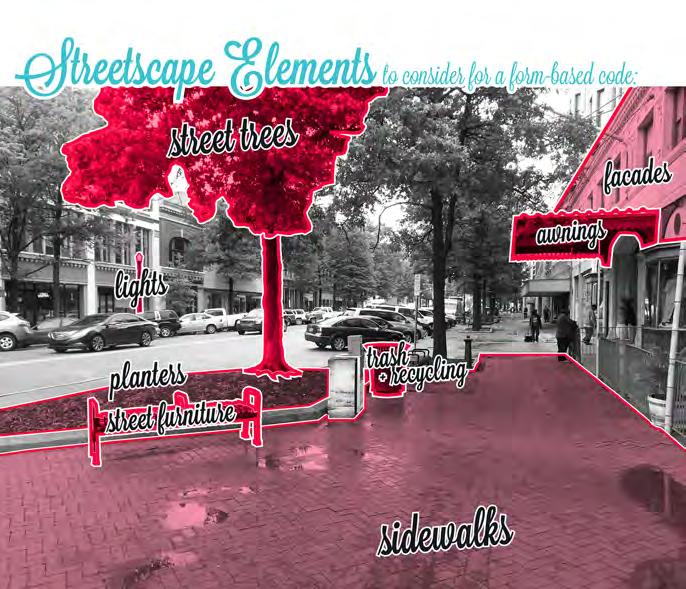
Additionally, in much of the Urban Core, utilities are located above ground. For pedestrians, this infrastructure is not aesthetically pleasing and can infringe on already limited sidewalk space. Further, aboveground utilities can hamper improvements to streetscaping, as trees conflict with power lines.
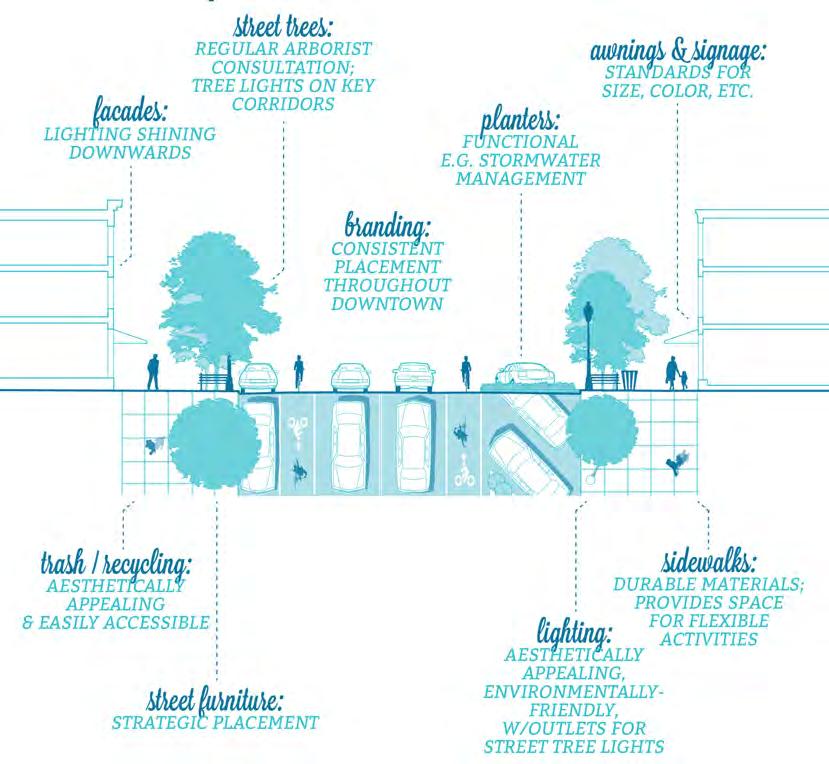
Key ideas: streetscape standards, sidewalk improvements, utility relocation
Action: Streetscape standards Develop streetscape standards as a part of the form-based code for the Urban Core that guide improvements to downtown streets including sidewalk treatments, landscaping, tree planting, lighting and furniture. Use these standards to procure specific permanent street furniture like benches or bus shelters.
Sidewalk improvements Start with improving the sidewalks on one to two streets downtown to pilot the approach. Utilities should be relocated either underground or closer to the street edge, to provide an improved pedestrian experience.
Utility relocation The relocation of utilities is an expensive undertaking, in particular if they are buried. Therefore, to help minimize costs, consideration should be given to relocating utilities as part of other infrastructure projects, such as streetscaping or roadway reconstruction.
4.3d) Make it easier to live in the Urban Core without a car
Background: One of the biggest differences in millennials as compared to previous generations is their lack of emphasis on owning a car. While the Urban Core will continue to support travel by car, a framework is necessary to support future residents and employees that are interested in a car-lite lifestyle.
While daily car usage is not a necessity for some, occasional usage is necessary for most. For example a car-lite lifestyle may still require the usage of a car for trips to the grocery store. In these instances, car share is a fitting solution. As with bike share, this program involves a membership but frees its users from the burdens of ownership. Car share allows its members to rent a car by the hour or day. Fees for renting typically include all expenses associated with owning a car (gas, insurance, and maintenance, among others). Car share cars are available from dedicated on-street spaces. Users reserve them in advance and are able to access them through a card or transponder scanner on the windshield of a given vehicle, thus sparing them the trip to a rental agency. Car share programs can also be used by the government to replace employee vehicles.
The Urban Core has three charging stations. Two additional charging stations were installed at Mercer University in the spring of 2013, and an additional station was installed in the spring of 2014 at Poplar Street and MLK Drive. In addition to assisting drivers of electric vehicles, these charging stations possess the potential to have an economic impact where they are located. The stations bring drivers off nearby interstates in to the Urban Core to recharge, which can take a few hours, and thus affords the drivers an opportunity to tour, shop, or dine in the area.

Taxi service is necessary even in areas with a high level of vehicle ownership, for example to transport out-of-town guests and support nightlife, among others. The current taxi system in the Urban Core, however, is unreliable and has a poor perception. This discourages use and can also have consequences for safety, as nightlife goers may opt to drink and drive.
Rideshare is an alternative to taxi service. It connects those who are in need of a ride with those who have a car. Though a smartphone application, consumers submit a trip request, to which crowd-sourced drivers with vehicles can respond. Consumers are able view the location of available drivers from their smartphones, and payment also takes place via the app. Further, drivers and consumers are able to rate each other, which incentivizes good behavior on both accounts.
Key ideas: car share, electric car infrastructure, ride share
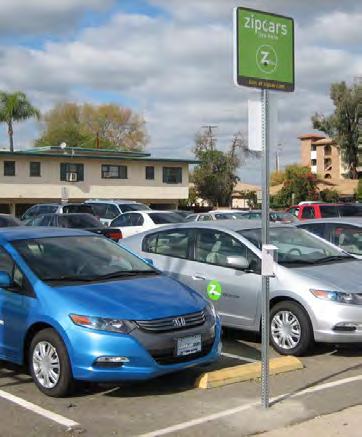
Action: Car share Establish a pilot car share program with a vendor. Macon-Bibb and the UDA should develop a pilot system for car share in downtown. This would include working with a vendor to place a few cars downtown for six to twelve months, marketing the service, and working with developers to encourage existing and future residents to use the service. It may also entail making up revenue gaps for the minimum monthly revenues vendors require.
Electric car infrastructure Electric car and scooter infra structure should be installed in high visibility areas where it will be used. There is currently one space on the corner of 2nd & Mulberry Street. Other potential locations include City Hall, Cherry Street, and Poplar Street.
Ride share Consideration should be given to allowing ride share companies, such as Uber and Lyft, to operate in Macon. This would provide an additional mobility option and reduce the unknowns of the current taxi system. Macon-Bibb should study the potential of allowing rideshare companies to operate in downtown.
HOW IT’S DONE ELSEWHERE
Zipcar, Baltimore, Maryland
One year after introducing its car sharing service in Baltimore, Zipcar polled its users to assess the impact of the program on driver behavior. Users reported a less car-heavy lifestyle after joining the program: 18% had sold their vehicles after joining Zipcar, 46% avoided buying a car, and 72% stated that they would be less likely to buy a car in the future. Furthermore, participants noted an increase in using other modes of transportation: 14% noted that they biked more. 21% walked more, and 11% opted for using public transportation more. A notable outcome is that there are fewer cars on the streets in Baltimore. Mayor Stephanie Rawlings-Blake adds that the service has helped the city reduce congestion and better manage parking.
www.smartgrowthamerica.org/2011/07/20/how-carsharing-can-help-acity-the-impact-of-zipcar-in-baltimore/







